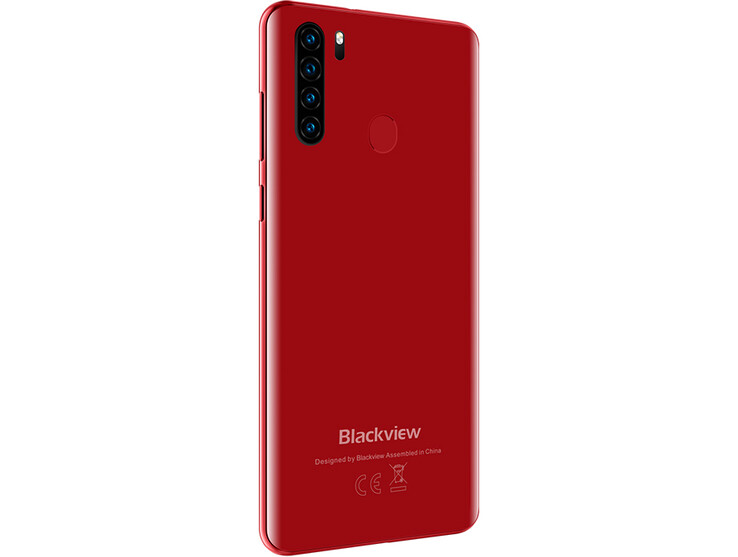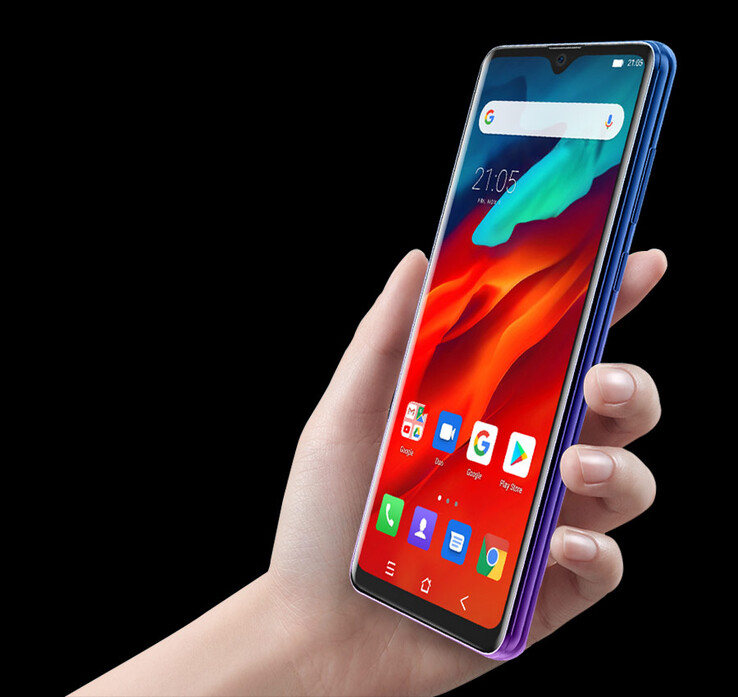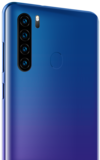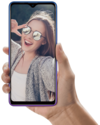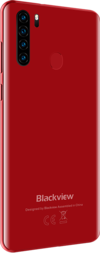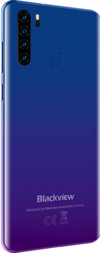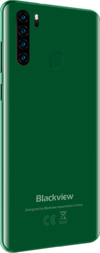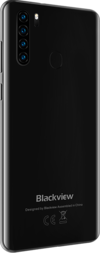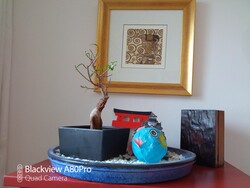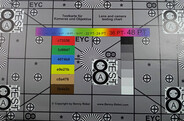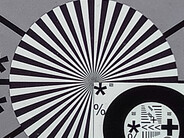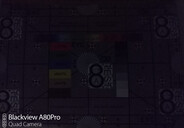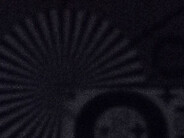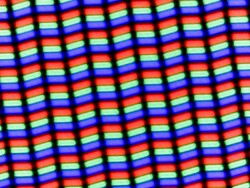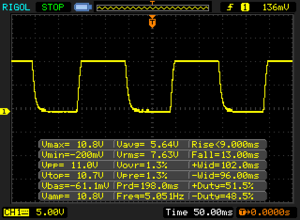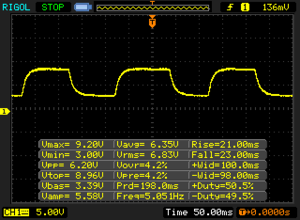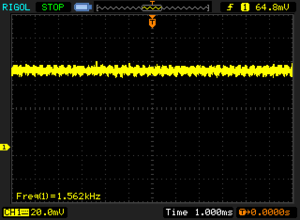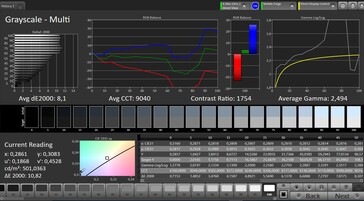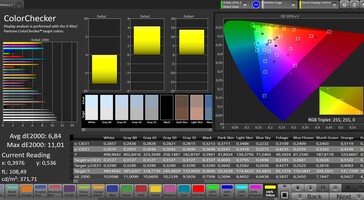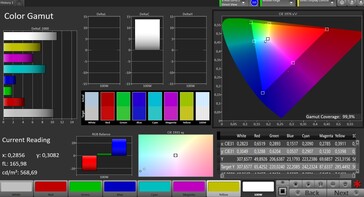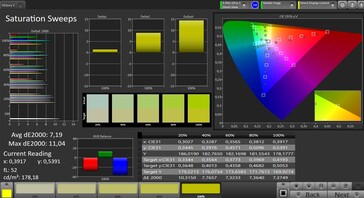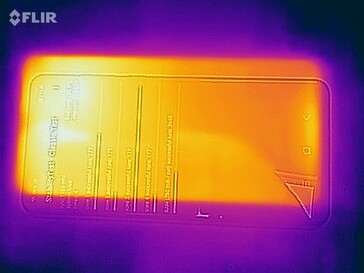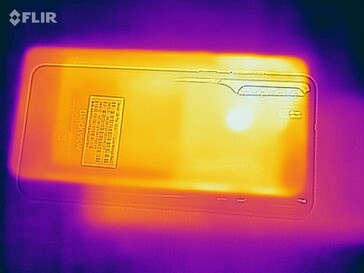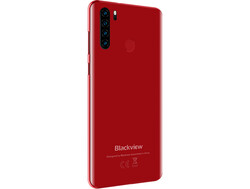Blackview A80 Pro Smartphone Review – Inexpensive with Good Running Time
Comparison Devices
Bewertung | Rating Version | Datum | Modell | Gewicht | Laufwerk | Groesse | Aufloesung | Preis ab |
|---|---|---|---|---|---|---|---|---|
| 74.5 % v7 (old) | v7 (old) | 03 / 2020 | Blackview A80 Pro Helio P25, Mali-T880 MP2 | 180 g | 64 GB eMMC Flash | 6.49" | 1560x720 | |
| 76.1 % v7 (old) | v7 (old) | 01 / 2020 | Xiaomi Redmi 8 SD 439, Adreno 505 | 188 g | 64 GB eMMC Flash | 6.22" | 1520x720 | |
| 75.3 % v7 (old) | v7 (old) | 01 / 2020 | Huawei Y6s Helio P35 MT6765, PowerVR GE8300 | 150 g | 32 GB eMMC Flash | 6.09" | 1560x720 | |
| 74.3 % v7 (old) | v7 (old) | 01 / 2020 | Nokia 2.3 Helio A22 MT6761, PowerVR GE8300 | 183 g | 32 GB eMMC Flash | 6.20" | 1520x720 |
Case, Equipment and Operation - Plastic and lots of LTE
The Blackview A80 Pro's plastic case barely stands out from the crowd; it's a glossy case with a narrow display bezel and a waterdrop notch. Besides black, there are also red, green and blue with a chic color gradient as colors. With a weight of 180 grams, the smartphone is roughly on par with other smartphones in its price range. Those who want a much lighter phone can choose the somewhat smaller Huawei Y6s. The Blackview A80 Pro's stability is decent, only strong pressure gets through to the screen.
WLAN according to 802.11 b/g/n or WiFi 4 is common in this price range, the test device thus achieves average speeds for its price range in our test with the reference router Linksys Nighthawk AX12. More pleasing is that Blackview supports numerous LTE networks, making the Blackview A80 Pro a smartphone that can be used almost anywhere in the world, which is nice when you travel a lot. NFC is not available on the smartphone, but there are two SIM slots, one of which can be used for a microSD card.
The fingerprint sensor on the back unlocks the smartphone reliably, but with a small delay. The smartphone can also be unlocked by face recognition. The touch screen gives no reason for criticism: The smartphone can be operated without any problems. On the right are the physical controls for volume and standby, they don't look overly sophisticated, but can be used reliably in everyday life.
| Networking | |
| iperf3 transmit AX12 | |
| Nokia 2.3 | |
| Huawei Y6s | |
| Blackview A80 Pro | |
| Xiaomi Redmi 8 | |
| iperf3 receive AX12 | |
| Nokia 2.3 | |
| Huawei Y6s | |
| Blackview A80 Pro | |
| Xiaomi Redmi 8 | |
Cameras - Passable Quality
At the back of the Blackview A80 Pro there are four cameras. Apart from the main camera with 13 megapixels (Sony IMX258), the other lenses only offer very low resolutions and are also not used for independent photos. Thus, there is no separate black and white lens as in some Huawei cell phones and also no hybrid optical zoom. What exactly the three lenses do, the manufacturer does not reveal, probably the lenses mainly help to calculate bokeh blurs in the background of the image.
Our test photos offer a decent light output under cloudy skies. If you get closer to the picture, you can quickly see individual pixels. We like the sharpness of the image quite well for such a cheap smartphone. With very little light, sharpness is quickly lost and a strong blue cast comes into play. If you look at the test chart that we took in the photo studio under fixed light conditions, you'll notice a lack of contrast in dark colors, but the sharpness is quite acceptable.
Videos can be recorded in 1080p at most, the autofocus is a bit slow and doesn't always find the perfect sharpness. But the exposure quickly adapts to the situation.
The front camera resolves with 8 megapixels. It takes decent pictures, which even offer quite good contrasts, but details quickly appear pixelated.
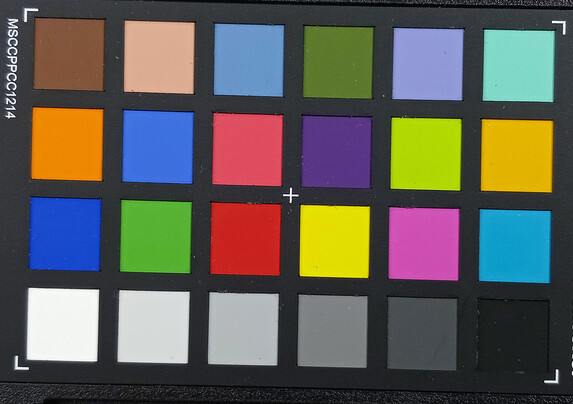
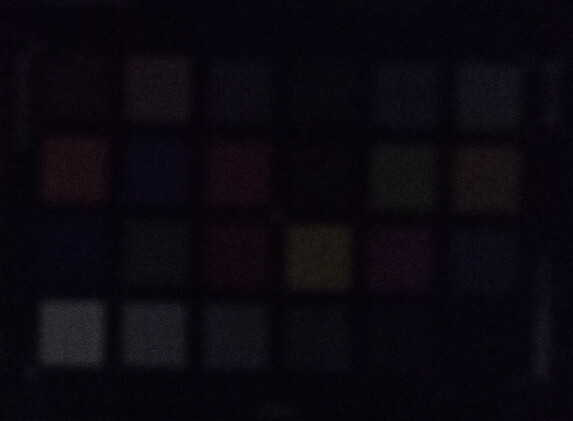
Display - Bright But with Blue Cast
The Blackview A80 Pro's display is on par in terms of resolution, it's even quite good in terms of brightness and is evenly lit. The black value isn't on top level, but it's also not bad for the price range.
With the exactness of the colour representation, which we determine with the CalMAN software and the spectrophotometer, the deviations are quite large and in the greyscales a bright blue cast becomes visible.
We only detect PWM flickering with an extremely high frequency, so that even sensitive persons should not have any problems here. The display's reaction times are too slow for demanding tasks.
| |||||||||||||||||||||||||
Brightness Distribution: 93 %
Center on Battery: 565 cd/m²
Contrast: 1766:1 (Black: 0.32 cd/m²)
ΔE ColorChecker Calman: 6.84 | ∀{0.5-29.43 Ø4.77}
ΔE Greyscale Calman: 8.1 | ∀{0.09-98 Ø5}
99.9% sRGB (Calman 2D)
Gamma: 2.49
CCT: 9040 K
| Blackview A80 Pro IPS, 1560x720, 6.5" | Xiaomi Redmi 8 IPS LCD, 1520x720, 6.2" | Huawei Y6s IPS, 1560x720, 6.1" | Nokia 2.3 IPS, 1520x720, 6.2" | |
|---|---|---|---|---|
| Response Times | -65% | -28% | -10% | |
| Response Time Grey 50% / Grey 80% * (ms) | 44 ? | 68.8 ? -56% | 54 ? -23% | 49.2 ? -12% |
| Response Time Black / White * (ms) | 24 ? | 41.6 ? -73% | 32 ? -33% | 25.6 ? -7% |
| PWM Frequency (Hz) | 1562 ? | 100 ? | 7692 ? | |
| Screen | 28% | -15% | 3% | |
| Brightness middle (cd/m²) | 565 | 554 -2% | 424 -25% | 515 -9% |
| Brightness (cd/m²) | 554 | 516 -7% | 397 -28% | 488 -12% |
| Brightness Distribution (%) | 93 | 85 -9% | 85 -9% | 92 -1% |
| Black Level * (cd/m²) | 0.32 | 0.24 25% | 0.35 -9% | 0.23 28% |
| Contrast (:1) | 1766 | 2308 31% | 1211 -31% | 2239 27% |
| Colorchecker dE 2000 * | 6.84 | 2.6 62% | 6.45 6% | 6.1 11% |
| Colorchecker dE 2000 max. * | 11.01 | 4.9 55% | 12.76 -16% | 13.4 -22% |
| Greyscale dE 2000 * | 8.1 | 2.7 67% | 8.5 -5% | 7.7 5% |
| Gamma | 2.49 88% | 2.17 101% | 2.231 99% | 2.26 97% |
| CCT | 9040 72% | 6814 95% | 9108 71% | 8639 75% |
| Total Average (Program / Settings) | -19% /
9% | -22% /
-17% | -4% /
1% |
* ... smaller is better
Display Response Times
| ↔ Response Time Black to White | ||
|---|---|---|
| 24 ms ... rise ↗ and fall ↘ combined | ↗ 9 ms rise | |
| ↘ 13 ms fall | ||
| The screen shows good response rates in our tests, but may be too slow for competitive gamers. In comparison, all tested devices range from 0.1 (minimum) to 240 (maximum) ms. » 53 % of all devices are better. This means that the measured response time is worse than the average of all tested devices (20.2 ms). | ||
| ↔ Response Time 50% Grey to 80% Grey | ||
| 44 ms ... rise ↗ and fall ↘ combined | ↗ 21 ms rise | |
| ↘ 23 ms fall | ||
| The screen shows slow response rates in our tests and will be unsatisfactory for gamers. In comparison, all tested devices range from 0.165 (minimum) to 636 (maximum) ms. » 73 % of all devices are better. This means that the measured response time is worse than the average of all tested devices (31.6 ms). | ||
Screen Flickering / PWM (Pulse-Width Modulation)
| Screen flickering / PWM detected | 1562 Hz | ≤ 10 % brightness setting | |
The display backlight flickers at 1562 Hz (worst case, e.g., utilizing PWM) Flickering detected at a brightness setting of 10 % and below. There should be no flickering or PWM above this brightness setting. The frequency of 1562 Hz is quite high, so most users sensitive to PWM should not notice any flickering. In comparison: 53 % of all tested devices do not use PWM to dim the display. If PWM was detected, an average of 8083 (minimum: 5 - maximum: 343500) Hz was measured. | |||
Performance, Emissions and Battery life - Poor Speaker
With the MediaTek Helio P25 as a SoC, Blackview doesn't make a bad choice in this price range: The Blackview A80 Pro can keep up with similarly expensive devices in terms of both graphics performance and pure processor power, and in some cases even surpass them. Of course, it's not enough for demanding games, but in everyday life many simple apps should run without jerking.
Heating up under longer load isn't problematic, we measured a maximum of 37.4 °C. This is noticeable, but at no time critical.
The Blackview mobile phone's mono loudspeaker is located on the bottom, it only gets averagely loud. The sound shouldn't be good enough even for less demanding natures, it is very high frequency-heavy and not very defined. Vocals sound far away and music is rather a sound mush. It doesn't get any better at lower volumes either: the smartphone sounds muffled here. The sound output via Bluetooth and 3.5mm jack plug is good, though.
The battery lasts 15:52 hours, which is a decent value, but given the high capacity of 4,680 mAh, more would have been possible.
| PCMark for Android | |
| Work performance score (sort by value) | |
| Blackview A80 Pro | |
| Xiaomi Redmi 8 | |
| Huawei Y6s | |
| Average Mediatek Helio P25 (4465 - 7583, n=5) | |
| Work 2.0 performance score (sort by value) | |
| Blackview A80 Pro | |
| Xiaomi Redmi 8 | |
| Huawei Y6s | |
| Nokia 2.3 | |
| Average Mediatek Helio P25 (3795 - 5505, n=5) | |
| GFXBench | |
| on screen Aztec Ruins Normal Tier Onscreen (sort by value) | |
| Blackview A80 Pro | |
| Xiaomi Redmi 8 | |
| Huawei Y6s | |
| Nokia 2.3 | |
| Average Mediatek Helio P25 (n=1) | |
| Average of class Smartphone (6.2 - 166, n=210, last 2 years) | |
| 1920x1080 Aztec Ruins Normal Tier Offscreen (sort by value) | |
| Blackview A80 Pro | |
| Xiaomi Redmi 8 | |
| Huawei Y6s | |
| Nokia 2.3 | |
| Average Mediatek Helio P25 (n=1) | |
| Average of class Smartphone (3.4 - 367, n=210, last 2 years) | |
| on screen Aztec Ruins High Tier Onscreen (sort by value) | |
| Blackview A80 Pro | |
| Xiaomi Redmi 8 | |
| Huawei Y6s | |
| Nokia 2.3 | |
| Average Mediatek Helio P25 (n=1) | |
| Average of class Smartphone (0.85 - 144, n=211, last 2 years) | |
| 2560x1440 Aztec Ruins High Tier Offscreen (sort by value) | |
| Blackview A80 Pro | |
| Xiaomi Redmi 8 | |
| Huawei Y6s | |
| Nokia 2.3 | |
| Average Mediatek Helio P25 (n=1) | |
| Average of class Smartphone (1.2 - 146, n=210, last 2 years) | |
| Blackview A80 Pro | Xiaomi Redmi 8 | Huawei Y6s | Nokia 2.3 | Average 64 GB eMMC Flash | Average of class Smartphone | |
|---|---|---|---|---|---|---|
| AndroBench 3-5 | 8% | -4% | 22% | 24% | 1098% | |
| Sequential Read 256KB (MB/s) | 255 | 285.7 12% | 263.2 3% | 261.8 3% | 277 ? 9% | 2240 ? 778% |
| Sequential Write 256KB (MB/s) | 187.7 | 202.6 8% | 118 -37% | 149.2 -21% | 178.4 ? -5% | 1877 ? 900% |
| Random Read 4KB (MB/s) | 42.5 | 79 86% | 46.7 10% | 69.6 64% | 60.7 ? 43% | 298 ? 601% |
| Random Write 4KB (MB/s) | 15.6 | 7.33 -53% | 18.6 19% | 30.33 94% | 33.8 ? 117% | 345 ? 2112% |
| Sequential Read 256KB SDCard (MB/s) | 80.1 ? | 86.9 ? 8% | 80.9 ? 1% | 83.7 ? 4% | 77.4 ? -3% | |
| Sequential Write 256KB SDCard (MB/s) | 73.3 ? | 63.6 ? -13% | 60.6 ? -17% | 63.7 ? -13% | 58.3 ? -20% |
Temperature
(+) The maximum temperature on the upper side is 37.4 °C / 99 F, compared to the average of 35.2 °C / 95 F, ranging from 21.9 to 247 °C for the class Smartphone.
(+) The bottom heats up to a maximum of 37.4 °C / 99 F, compared to the average of 34 °C / 93 F
(+) In idle usage, the average temperature for the upper side is 31.4 °C / 89 F, compared to the device average of 32.9 °C / 91 F.
Lautsprecher
Blackview A80 Pro audio analysis
(±) | speaker loudness is average but good (79.6 dB)
Bass 100 - 315 Hz
(-) | nearly no bass - on average 26.4% lower than median
(±) | linearity of bass is average (11.6% delta to prev. frequency)
Mids 400 - 2000 Hz
(±) | higher mids - on average 10.3% higher than median
(±) | linearity of mids is average (8.4% delta to prev. frequency)
Highs 2 - 16 kHz
(±) | higher highs - on average 5.7% higher than median
(±) | linearity of highs is average (7.4% delta to prev. frequency)
Overall 100 - 16.000 Hz
(-) | overall sound is not linear (33.4% difference to median)
Compared to same class
» 84% of all tested devices in this class were better, 1% similar, 15% worse
» The best had a delta of 11%, average was 35%, worst was 134%
Compared to all devices tested
» 92% of all tested devices were better, 1% similar, 7% worse
» The best had a delta of 4%, average was 24%, worst was 134%
Xiaomi Redmi 8 audio analysis
(+) | speakers can play relatively loud (88.6 dB)
Bass 100 - 315 Hz
(-) | nearly no bass - on average 36.7% lower than median
(±) | linearity of bass is average (10.4% delta to prev. frequency)
Mids 400 - 2000 Hz
(±) | reduced mids - on average 5.6% lower than median
(+) | mids are linear (5.2% delta to prev. frequency)
Highs 2 - 16 kHz
(+) | balanced highs - only 1.5% away from median
(+) | highs are linear (1.9% delta to prev. frequency)
Overall 100 - 16.000 Hz
(±) | linearity of overall sound is average (20.1% difference to median)
Compared to same class
» 33% of all tested devices in this class were better, 9% similar, 58% worse
» The best had a delta of 11%, average was 35%, worst was 134%
Compared to all devices tested
» 51% of all tested devices were better, 8% similar, 41% worse
» The best had a delta of 4%, average was 24%, worst was 134%
Battery Life
| Blackview A80 Pro 4680 mAh | Xiaomi Redmi 8 5000 mAh | Huawei Y6s 3020 mAh | Nokia 2.3 4000 mAh | Average of class Smartphone | |
|---|---|---|---|---|---|
| Battery Runtime | |||||
| WiFi Websurfing (h) | 15.9 | 19.3 21% | 12.4 -22% | 15.3 -4% | 19.3 ? 21% |
Pros
Cons
Verdict - Qualities Away from The Camera
The Blackview A80 Pro is an affordable smartphone that offers decent battery life. The performance is also convincing in contrast to similarly expensive devices. The quadruple camera on the back shouldn't be alelrdings the purchase argument, as in reality it is a single camera and three auxiliary lenses with dubious benefits. Nevertheless, the pictures are of a decent quality, at least in a reasonably good light.
The bright screen and the many LTE networks, which allow use in many countries, are convincing. The chassis is nothing special, but it is stable and has a modern appearance.
The loudspeaker, on the other hand, is of poor quality, and the extreme blue cast in the display is also disturbing.
The Blackview A80 Pro doesn't have a real quad camera, but has good battery life and a bright display.
Overall, the Blackview A80 Pro offers decent equipment for its money. One should pay attention to the details: If you want a cheap device that can be used in many countries, the device is well suited. However, if you want great sound and a real multi-camera with a lot of flexibility in image composition, you're in the wrong place.
Blackview A80 Pro
- 03/16/2020 v7 (old)
Florian Schmitt


